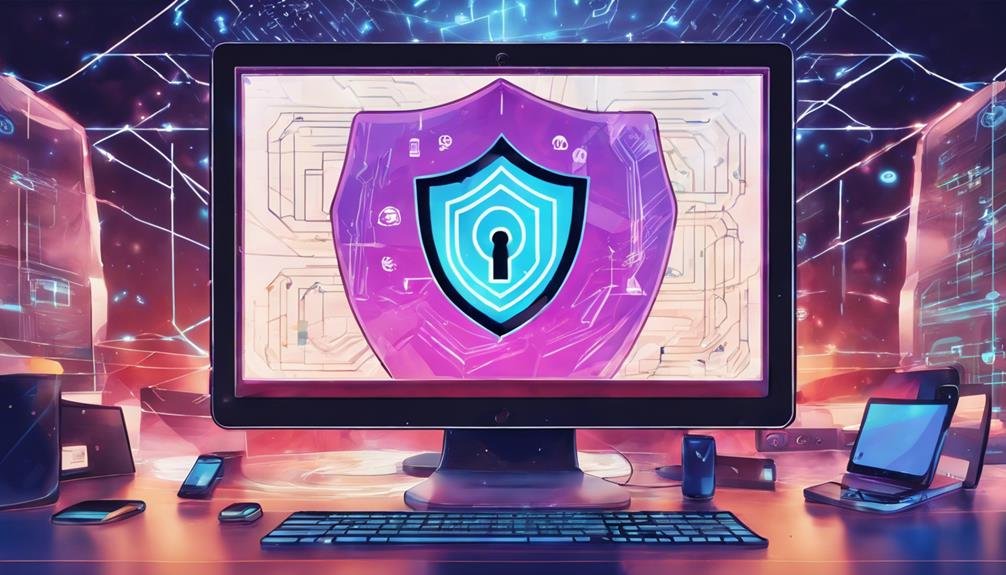How Do I Ensure Data Security and Privacy in Online Learning Environments?
To guarantee data security and privacy in online learning environments, prioritize strong passwords and implement multi-factor authentication. Use secure messaging platforms and encrypt data during transmission. Opt for reputable cloud storage with encryption. Regularly update software with security patches. Monitor user activities and implement strict access controls. Utilize robust encryption techniques like AES and TLS for secure data transmission. Remember, safeguarding data in online learning environments requires a multifaceted approach that includes secure authentication, encryption methods, and monitoring measures.
Key Takeaways
- Use secure messaging platforms for communication.
- Implement strong encryption for data protection.
- Regularly update software for security measures.
- Monitor user behavior to prevent unauthorized access.
- Backup critical data with encrypted cloud storage.
Importance of Data Privacy
Understanding the critical importance of data privacy is crucial in safeguarding sensitive information within online learning environments. To guarantee privacy laws compliance and prevent data breaches, rigorous risk assessment procedures must be implemented. Conducting regular risk assessments allows educational institutions to identify vulnerabilities in their systems and take proactive measures to mitigate potential threats. Additionally, robust privacy policy enforcement is essential to maintain data security standards. Institutions should regularly review and update their privacy policies to align with current regulations and best practices in data protection.
Incorporating data breach prevention strategies into the overall security framework of online learning platforms is paramount. By utilizing encryption protocols, access controls, and monitoring tools, institutions can greatly reduce the risk of unauthorized access to sensitive data. It's crucial to stay informed about emerging threats and continuously adapt security measures to address evolving challenges in data privacy. Prioritizing data privacy not only fosters a secure online learning environment but also instills trust among students, educators, and other stakeholders in the educational ecosystem.
Secure Authentication Methods
When it comes to ensuring data security in online learning environments, you must prioritize using strong passwords that are unique and difficult to guess.
Additionally, implementing multi-factor authentication adds an extra layer of security by requiring more than just a password for access.
Password Strength
Implementing robust password strength requirements is vital in online learning environments to guarantee secure authentication methods. When setting password policies, consider elements like password complexity to make sure users create strong passwords. Strong passwords help in user authentication, reducing the risk of unauthorized access. Additionally, emphasize password protection to enhance overall account security. Encourage users to create unique passwords for their accounts and avoid common phrases or easily guessable information. Regularly updating passwords and educating users on the importance of strong password practices are essential steps in maintaining a secure online learning environment.
| Password Strength Tips | Importance |
|---|---|
| Use a mix of characters (uppercase, lowercase, symbols) | Enhances security |
| Avoid using common words or sequential numbers | Prevents easy guessing |
| Regularly change passwords | Minimizes risk of breaches |
Multi-factor Authentication
Enhancing online learning environment security involves incorporating multi-factor authentication for robust and reliable user verification.
Multi-factor authentication enhances security by requiring users to provide two or more forms of verification before granting access. This could include something you know (like a password), something you have (like a mobile device), or something you are (like a fingerprint).
By implementing multi-factor authentication, online learning platforms can greatly reduce the risk of unauthorized access and data breaches. It adds an extra layer of protection beyond just passwords, making it harder for malicious actors to gain entry.
This method strengthens access control mechanisms and ensures that only authorized users can access sensitive information, enhancing overall data security and privacy.
Data Encryption Techniques
When considering data encryption techniques, it's important to focus on secure data transmission and the implementation of strong encryption methods.
Ensuring that data is securely transmitted between users and servers is essential in safeguarding sensitive information.
Implementing robust encryption algorithms can greatly enhance the security of online learning environments.
Secure Data Transmission
Data encryption techniques play a crucial role in guaranteeing secure data transmission in online learning environments. By encrypting data, information is converted into a secure code that can only be accessed by authorized users.
When data is transmitted over secure networks, such as Virtual Private Networks (VPNs) or Secure Sockets Layer (SSL) connections, encryption ensures that the information remains confidential and protected from unauthorized access. Secure networks establish a safe pathway for data to travel without being intercepted by malicious entities.
Encryption algorithms like Advanced Encryption Standard (AES) and Transport Layer Security (TLS) are commonly used to safeguard data during transmission, providing a secure environment for online learning platforms to operate efficiently and protect sensitive information.
Strong Encryption Methods
Implementing robust encryption methods is vital for ensuring data security in online learning environments. Secure data transmission relies on encryption protocols to safeguard information from unauthorized access.
Strong encryption techniques like Advanced Encryption Standard (AES) and Rivest-Shamir-Adleman (RSA) are commonly used to protect data integrity and confidentiality. AES, a symmetric encryption algorithm, guarantees secure communication by encrypting and decrypting data using a secret key.
In contrast, RSA, an asymmetric encryption method, leverages public and private keys for secure data exchange between parties. These encryption protocols play an essential role in preventing data breaches and maintaining privacy in online learning platforms.
Regular Software Updates
To maintain a secure online learning environment, it is essential to regularly update the software used, ensuring protection against potential vulnerabilities and cyber threats. Regular software updates are vital for enhancing data maintenance and software security. By keeping your software up to date, you are not only improving the performance of your online learning platform but also safeguarding sensitive information from unauthorized access.
Importance of Regular Software Updates
| Benefits | Description | Impact |
|---|---|---|
| Enhanced Security | Patches security vulnerabilities | Minimizes risks |
| Improved Functionality | Introduces new features | Enhances user experience |
| Bug Fixes | Resolves software issues | Ensures smooth operation |
Failing to update your software regularly can leave your online learning environment susceptible to cyberattacks and data breaches. Make it a practice to check for updates frequently and install them promptly to maintain a secure and efficient virtual learning space.
Safe Online Communication Practices
Guarantee secure and effective online communication by adhering to best practices for maintaining privacy and data protection. When engaging in online communication within virtual classrooms, it's important to use secure messaging platforms that encrypt data to prevent unauthorized access. Platforms that offer end-to-end encryption provide an added layer of security to your conversations. Additionally, always follow proper online etiquette to ensure respectful and professional communication.
In addition to using secure messaging platforms, familiarize yourself with the virtual classroom security features and privacy policies. Understand who's access to the communication within the platform and what measures are in place to protect your data. Be cautious about sharing personal information and adhere to the guidelines set forth by the platform.
Secure File Storage Solutions
Safeguard the security of your digital assets by utilizing robust and encrypted file storage solutions in online learning environments. When considering secure file storage solutions, opt for reputable cloud storage options that offer encryption at rest and in transit. Encrypted drives provide an additional layer of protection by guaranteeing that even if the physical drive is compromised, the data remains secure.
Access control is essential in maintaining data security. Implement strict access controls to make sure that only authorized individuals can view, edit, or share files. Utilize multi-factor authentication and strong passwords to prevent unauthorized access to sensitive information stored in the cloud or on encrypted drives.
Data protection should be a top priority when selecting file storage solutions for online learning. Regularly backup your data to prevent any loss in case of a security breach or system failure. Additionally, consider implementing data encryption policies to safeguard information both in storage and during transmission. By prioritizing access control and data protection measures, you can enhance the security of your online learning environment.
Monitoring and Compliance Measures
Implement robust monitoring and compliance measures to safeguard the security and integrity of data in online learning environments. Data monitoring plays an important role in tracking access to sensitive information, identifying unusual patterns, and detecting potential security breaches. By continuously monitoring data flows, system administrators can quickly respond to any suspicious activities and mitigate risks effectively. Automated alerts and real-time monitoring tools enhance the overall security posture of online platforms by providing instant notifications of any deviations from established security protocols.
Compliance checks are vital to make sure that online learning environments adhere to regulatory requirements and industry standards. Regular audits and assessments help verify that data protection measures are in place and functioning correctly. Compliance checks also involve monitoring user behavior to prevent unauthorized access and maintain data privacy. By implementing stringent compliance measures, organizations can demonstrate their commitment to protecting sensitive information and maintaining a secure online learning environment for all users. Regularly reviewing and updating compliance policies is crucial to staying ahead of emerging threats and ensuring data security in online educational settings.
Data Backup and Recovery Strategies
To guarantee the resilience of data in online learning environments, establishing robust data backup and recovery strategies is vital. Disaster recovery plays an essential role in making sure that in the event of data loss or corruption, systems can be restored efficiently.
Implementing a thorough disaster recovery plan involves regular backups of all critical data. Utilizing cloud storage for backups can provide added security and accessibility, allowing for data to be stored off-site and easily recovered in case of emergencies.
Cloud storage offers scalability, cost-effectiveness, and automated backups, reducing the risk of data loss. It's essential to choose a reputable cloud service provider that offers encryption and compliance with data protection regulations to safeguard the security and privacy of backed-up data. Regularly testing the backup and recovery processes is crucial to identify any potential weaknesses and ensure a quick and effective response in case of data loss.
Conclusion
In summary, safeguarding data security and privacy in online learning environments is vital for protecting sensitive information. Remember, 'prevention is better than cure.'
By implementing secure authentication methods, data encryption techniques, regular software updates, safe online communication practices, secure file storage solutions, monitoring and compliance measures, and data backup and recovery strategies, you can guarantee a safe and protected online learning experience.
Stay vigilant and proactive in maintaining the integrity of your data.







